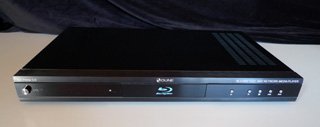 With the sheer number of Network Media Players on the market today, manufacturers are increasingly looking to find a clever angle to distinguish their products from the others. In putting a Blu-Ray drive inside the BD Prime 3.0, HDi Dune’s angle is more of a convergence. A convergence of everything HD.
With the sheer number of Network Media Players on the market today, manufacturers are increasingly looking to find a clever angle to distinguish their products from the others. In putting a Blu-Ray drive inside the BD Prime 3.0, HDi Dune’s angle is more of a convergence. A convergence of everything HD.
Read on for our review.
First Impressions
At a glance, the BD Prime 3.0 looks to be a typical slimline Blu-Ray player. Its overall appearance is neat and its combination of brushed aluminium and ultra glossy black plastic matches its hi-fi component dimensions.
On the far right of the unit is a push button on/off switch, which sits to the left of the unit’s display. Next to this is the centrally located Blu-Ray drive sporting a rather large (and very blue) "Blu-Ray Drive" logo at its centre. To the right of the drive are five circular buttons which can be used to operate the unit’s basic playback functions.

While the central Blu-Ray Disc logo may not be to everyone’s taste, our only aesthetic complaint was the unit’s unnecessary and somewhat obtrusive "BD Prime 3.0" and "BLU-RAY DISC AND NETWORK MEDIA PLAYER" labels on the upper face. Thankfully, both the Blu-Ray logo’s blueness and capitalised labelling lost its impact once the unit was placed inside a hi-fi/TV cabinet.

The rear panel is well populated as expected. From left to right the BD Prime 3.0’s rear panel features Ethernet, USB 2.0, HDMI, RCA Audio out, Component Out, Composite Out, USB 2.0, eSATA, 7.1 RCA Audio out and finally a three prong PC style power port on the far right.

Along with a large vent, the unit’s top has an embossed Dune logo on it. The side panels are generally unremarkable other than a USB 2.0 port on the right, and a rather crude "WARRANTY VOID IF DAMAGED OR REMOVED" sticker on the left. A disused fan vent is also visible on this side.
In the Box
As the BD Prime 3.0 unit we received was a reseller package, it came without a manual and with some additional internal cables and screws normally unseen by the end user. Regular retail units come with a region specific manual and can be configured by the reseller to house an internal hard drive as an option. Other options include a Wi-Fi 802.11n adapter as well as an RF Remote system (due in the first quarter of 2010).
Along with a short length of HDMI cable, and some internal reseller parts which can be seen in the images, our BD Prime 3.0 came with a set of standard RCA cables, a SATA to USB connector and two AA batteries.

While the included remote control’s buttons were reasonably sized and a logically laid out, the buttons were neither backlit or glow-in-the-dark. The velvety, slightly soft and rubbery plastic the remote was fashioned from however, felt great in the hand and the expertly placed finger grooves on its underside sat the remote in the hand comfortably.
The unit also came with a foreign power cable which we replaced with a standard Australian PC power cable to get up and running.
Beneath the Skin
While opening the BD Prime 3.0 was as easy as removing six philips screws, a quick warning to the brave: Opening the unit not only voids the warranty, but also leaves a nasty VOID pattern where the warning sticker used to be.

The internal layout of the unit is neatly arranged in three general sections – The main board/hard drive mount, the Blu-Ray drive and the power supply. A closer look at the main board reveals a MINI PCI connector presumably for for a Wi Fi adapter as well as two SATA connectors which are both in use. One connector is used for the Blu-Ray drive while the other is connected to the rear eSATA port. From our reckoning, installing an internal hard drive will render the rear SATA port inactive which may go some way to explaining the inclusion of the SATA to USB connector in the reseller kit.

Two USB ports are also present but hidden beneath the 2.5" hard drive mounting plate on the front left hand side. One of these ports is filled with a small USB drive, presumably with enough flash storage to make playback of BD Live content possible.

There are no cooling fans inside but as mentioned earlier, there are provisions for one on the right side near the power supply. How one would go about fitting a fan without voiding the warranty however, is anybody’s guess.
Usage
We’ve been using the BD Prime 3.0 as our primary media player for about a month now and we have to say, we’re impressed.
Throughout our time with the unit we played back a multitude of AVI and MKV files as well as some WMV and of course, the odd Blu-Ray disc. We also gave some Blu-Ray and DVD ISO files a run as well as a few FLV files.

Overall the playback of the unit was excellent. All AVI files tested played back perfectly – from low resolution right up to 720p, all played back flawlessly. While 720p and 1080p MKV files looked superb on our plasma, we found that audio on some tested MKV files was out of sync.
All WMV files played back without issue including those with WMAPro 5.1 channel audio.
While the previously reviewed Popcorn Hour C-200 had some issues with a Blu-Ray ISO test file, the Dune managed to play back this and another Blu-Ray ISO file (over the network) without any problem whatsoever. This may partly be due to the BD Prime’s "Advanced Playback Accelerator" function which aims to make up for Sigma Design’s unwillingness to effectively support Gigabit Ethernet.
Playback of physical Blu-Ray discs was flawless with the handful of discs we tested exhibiting zero problems. In the BD Prime 3.0, HDi-Dune have created a genuine all encompassing High definition solution which effectively removes the need for a standalone Blu-Ray player.

Out of all formats tested, FLV was the only format that the BD Prime 3.0 flatly refused to play.
The BD Prime 3.0’s interface is neat and probably the best looking we have come across, other than the rich UI previews and the simply other league XBMC/Plex GUI. The BD Prime 3.0’s GUI looks polished and is effective for rummaging through files and adjusting settings. Like the remote control, the GUI feels good. It’s not outstanding but its well built, simple and feels like it has been created with the end user in mind.
Unlike the Popcorn Hour units, the Menu system employs a "Pop up menu" contextual menu approach. While it took a little getting used to, we found it to be quite natural after a few sittings. While the basic theme isn’t changeable (at least not via the on screen settings), the onscreen display can be changed from large icons (pictured) to a more regular list view.

The entire interface is snappy and button presses on the remote control were quickly and fluently represented on screen in all but one aspect: Playback. The amount of time between pressing the play button and actually seeing the start of a video ranged from a few seconds to a few seconds too long. Thankfully the current beta firmware seems to be tackling this issue, so we suspect the next public firmware release will put this problem to bed.

The only other niggle worth mentioning was the unit’s inability to play nice with HDMI-CEC or as Pioneer likes to call it, Kuro Link. This is endemic to the segment as every other player we have reviewed has made a hash of working with our HDMI-CEC capable receiver and television.
The unit’s stability was good and in all our time testing the BD Prime, only once did it suffer from a restart inducing crash.
All in all we felt the BD Prime’s performance was on par with the class leading Popcorn Hour C-200: Sometimes slightly better (Blu-Ray ISO/Physical Discs); sometimes slightly worse (Playback start speed).
As well as video playback, the BD Prime peripherally supports IPTV, Internet Radio support, Torrent Client and photo viewing.
Specifications
Processor: Sigma Designs 8642
Memory: RAM 512 MB, system Flash: 128 MB, expandable with a HDD partition or USB flash drive (2GB recommended)
Media sources: built-in Blu-ray drive, external HDD (eSATA, USB), external optical drive (eSATA, USB), USB devices (USB flash drive, USB card reader, etc), PC and NAS in local network (SMB, NFS, UPnP, HTTP), internal 2.5" SATA HDD (option)
Video codecs: MPEG2, MPEG4, XVID, WMV9, VC1, H.264
Video file formats: MKV, MPEG-TS, MPEG-PS, M2TS, VOB, AVI, MOV, MP4, QT, ASF, WMV, Blu-Ray-ISO, BDMV, DVD-ISO, VIDEO_TS
Video output modes: wide range of supported modes and resolutions, including 23.976p, 24p, PAL, NTSC
Audio codecs: AC3 (Dolby Digital), DTS, MPEG, AAC, LPCM, WMA, WMAPro, EAC3 (Dolby Digital Plus), Dolby True HD, DTS HD High Resolution Audio, DTS HD Master Audio, FLAC, multichannel FLAC
Audio file formats: MP3, MPA, M4A, WMA, FLAC, WAV, DTS-WAV, DTS, AC3, AAC
Pass-through and decoding of HD audio formats, including Dolby TrueHD and DTS HD Master Audio
Picture file formats: JPEG, PNG, BMP, GIF
Subtitle formats: SRT, SUB, text/SSA/ASS (MKV), VobSub (MP4), PGS (full Blu-ray mode)
Playlist file formats: M3U, PLS
Filesystems: FAT16/FAT32 (read-write), EXT2/EXT3 (read-write), NTFS (readonly)
 Conclusion
Conclusion
In creating the BD Prime 3.0, HDi-Dune have created an all in one solution that is just that. With flawless Blu-Ray playback and support of all major video codecs/file formats wrapped up in a neat GUI, the BD Prime is an obvious candidate for our Editor’s Choice Award.
The MKV audio sync issues we experienced do require attention but we have faith that HDi-Dune will solve the issue via firmware update. While we have little experience with the frequency (and quality) of HDi-Dune’s firmware releases, we suggest that the "user voting" scheme they employ to be a positive sign.
Also worth noting is that at $499US, the BD Prime 3.0’s "just works" capability may seem expensive compared to the Popcorn Hour C-200’s $299US. This is misleading. If you read our previous C-200 review, you would know that to get the Popcorn Hour to play Blu-Ray discs requires the added purchase of a Blu-Ray drive, which at the time cost an addition $170US.
If you want something that plays (nearly) everything straight out of the box, the BD Prime 3.0 is a sensible choice.
Our rating? A very high 9/10 which entitles it to our Editor’s Choice Award!

For more information about the BD Prime 3.0, including where to buy, please visit HDi-Dune’s consumer website.


